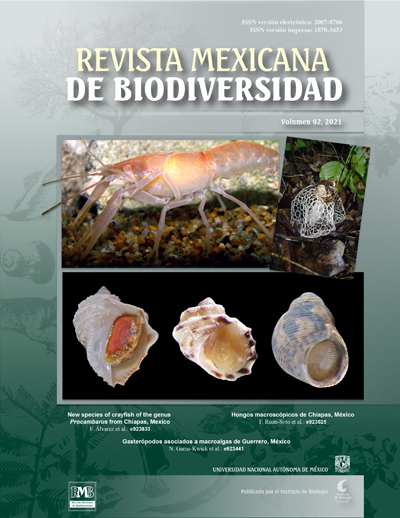New records of the genus Lobophora (Dictyotales: Phaeophyceae) for the marine flora of Cuba and their distribution in the Greater Caribbean Sea
DOI:
https://doi.org/10.22201/ib.20078706e.2021.92.3538Palabras clave:
Greater Antilles, Habitat, Morphological taxonomy, Seaweeds, Western CubaResumen
To date, 18 species of the algal genus Lobophora (Dictyotales, Phaeophyceae) have been reported for the Greater Caribbean Sea. Nevertheless, only 2 have been recorded for the marine flora of Cuba, Lobophora variegata and Lobophora canariensis (as Aglaozonia canariensis). To update the knowledge about this genus in Cuba, an exhaustive morphological study was performed using macroalgae collected from Western Cuba: Ecological Reserve Los Pretiles
(Pinar del Río Province; May 2011), Gulf of Guanahacabibes (Pinar del Río Province; June 2014) and Calle 16 beach (La Habana Province; April and May 2019). The species found were: L. canariensis, L. declerckii, L. guadeloupensis, L. littlerorum and L. variegata. The identified species were deposited in the Cuban National Aquarium Herbarium (HANC). Morphological descriptions from Cuban material are here presented. In addition, the distribution of these species in the Greater Caribbean Sea is undertaken. We report for the first time L. guadeloupensis in the Greater Antilles. These new records increase the specific richness in Cuba and expand the distribution range of Lobophora species for the Greater Caribbean Sea.
Citas
Ballantine, D. L., Ruiz, H., & Norris, J. N. (2019). Notes on
the benthic marine algae of Puerto Rico. XII: additions
to the flora. Botanica Marina, 62, 337–344. https://doi.
org/10.1515/bot-2018-0117.
Camacho, O., Fernández-García, C., Vieira, C., Gurgel, D.,
Norris, J. N., Freshwater, D. W. et al. (2019). The systematics
of Lobophora (Dictyotales, Phaeophyceae) in the Western
Atlantic and Eastern Pacific ocean: eight new species.
Journal of Phycology, 55, 611–624. https://doi.org/10.1111/
jpy.12850.
Coen, L., & Tanner, C. (1989). Morphological variation and
differential susceptibility to herbivory in the tropical brown
alga Lobophora variegata. Marine Ecology Progress Series,
, 287–98. https://doi.org/10.3354/MEPS054287.
De Clerck, O., Guiry, M. D., Leliaert, F., Samyn, Y., &
Verbruggen, H. (2013). Algal taxonomy: a road to nowhere?
Journal of Phycology, 49, 215–225. https://doi.org/10.1111/
jpy.12020.
Delnatte, C., & Wynne, M. J. (2016). A revised checklist of marine
algae and seagrasses of Martinique, French West Indies.
Nova Hedwigia, 102, 415–440. https://doi.org/10.1127/
nova_hedwigia/2016/0364.
De Ruyter van Steveninck, E., Kamermans, P., & Breeman,
A. (1988). Importance of physical and biological process
in structuring tropical intertidal population of Lobophora
variegata (Phaeophyceae). Marine Ecology Progress Series,
, 77–84. https://doi.org/10.3354/meps044077.
Duran, A., Shantz, A. A., Burkepile, D. E., Collado-Vides, L.,
Ferrer, V. M., Palma, L. et al. (2018). Fishing, pollution,
climate change, and the long-term decline of coral reefs of
Havana, Cuba. Bulletin of Marine Science, 94, 213–228.
https://doi.org/10.5343/bms.2017.1061.
Godínez-Ortega, J. L., Cabrera, L. I., García-Sandoval, R.,
Wynne, M. J., Olivares-Rubio, H. F., Ramírez-García, P.
et al. (2018). Morphological and molecular characterization
of Lobophora declerckii and L. variegata (Dictyotales,
Ochrophyta) on the Atlantic coast of Mexico. Phytotaxa,
, 57–73. https://doi.org/10.11646/phytotaxa.382.1.2. 57.
Guiry, M. D., & Guiry, M. G. (2020). AlgaeBase. World-wide
electronic publication. National University of Ireland,
Galway. Retrieved on 14 April 2020 from: http://www.
algaebase.org.
Humm, H. J., & Jackson, C. R. (1955). A collection of marine
algae from Guantanamo Bay, Cuba. Bulletin of Marine
Science of the Gulf and the Caribbean, 5, 240–246.
Littler, D. S., & Littler, M. M. (2000). Caribbean reef plants.
Washington, D.C.: OffShore Graphics.
RStudio Team (2021). RStudio. Integrated development for R.
RStudio, PBC, Boston, MA URL http://www.rstudio.com/.
Schultz, N. E., Lane, C. E., Gall. L. L., Bigney, D. A. R., Reviers,
B. D., Rousseau, F. et al. (2015). A barcode analysis of
the genus Lobophora (Dictyotales, Phaeophyceae) in the
Western Atlantic Ocean with four novel species and the
epitypification of L. variegata (J.V. Lamouroux) E.C.
Oliveira. European Journal of Phycology, 50, 481–500.
https://doi.org/10.1080/09670262.2015.1078500.
Silva, P. C., Basson, P. W., & Moe, R. L. (1996). Catalogue
of the benthic marine algae of the Indian Ocean. Berkeley:
University of Califormia Press.
Suárez, A. M., Martínez-Daranas, B., & Alfonso, Y. (2015).
Macroalgas marinas de Cuba. La Habana, Cuba: Editorial
UH.
Sun, Z., Hanyuda, T., Lim, P. E., Tanaka, J., Gurgel, C. F.
D., & Kawai, H. (2012). Taxonomic revision of the
genus Lobophora (Dictyotales, Phaeophyceae) based
on morphological evidence and analyses rbcL and cox3
gene sequences. Phycologia, 51, 500–512. https://doi.
org/10.2216/11-85.1.
Vieira, C., Camacho, O., Wynne, M. J., Mattio, L., Anderson,
R. J., Bolton, J. J. et al. (2016). Shedding new light on old
algae: Matching names and sequences in the brown algal
genus Lobophora (Dictyotales, Phaeophyceae). Taxon, 65,
–707. https://doi.org/10.12705/654.1.
Vieira, C., Camacho, O., Sun, Z., Fredericq, S., Leliaert, F.,
Payri, C. et al. (2017). Historical biogeography of the
highly diverse brown seaweed Lobophora (Dictyotales,
Phaeophyceae). Molecular Phylogenetics and Evolution,
, 81–92. https://doi.org/10.1016/j.ympev.2017.03.007.
Vieira, C., Henriques, F., D’hondt, S., Neto, A. I., Almada, C. H.,
Kaufmann, M. et al. (2020). Lobophora (Dictyotales) species
richness, ecology and biogeography across the North-Eastern
Atlantic archipelagos and description of two new species.
Journal of Phycology, 56, 346–357. https://doi.org/10.1111/
jpy.12956.
Vieira, C., Morrow, K., D´Hondt, S., Camacho, O. Engelen, A. H.,
Payri, C. E. et al. (2020). Diversity, ecology, biogeography,
and evolution of the prevalent brown algal genus Lobophora
in the Greater Caribbean Sea, including the description of
five new species. Journal of Phycology, 56, 592–607. https://
doi.org/10.1111/12986.




